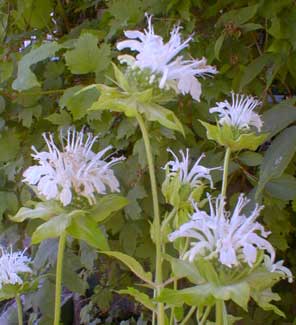
'Snow White'
Bee-balm or Bergamot
"For the sake of some things
That be now no more
I will strew rushes
On my chamber-floor,
I will plant bergamot
At my kitchen-door."
-Edna St Vincent Millay
(1892-1950)
(1892-1950)
'Snow White' bee-balm was introduced in 1955. The three best known standard whites are 'Snow Maiden,' 'Snow Queen,' & 'Snow White,' intentionally alluding to fairy tale figures, in part because the tight flowers do look like fairy queen crowns.
The handsome, petite, crown-like flowers of 'Snow White' are only about half the size of the blooms on our red bee-balms 'Jacob Kline' & 'Raspberry Wine,' but they are even so very showy. The leaves are also smaller than with our other bee-balms.
Most cultivars or the northeastern American wildflower, though designated Monarda didyma, are actually hybrids with at least a bit of M. fistulosa in their breeding history, thus sometimes referred to as hybrid monardas. But this smaller pure white hybrid more likely has the white-flowering M. clinopodia mixed into it.
Unfortunately the older standard hybrids are nearly always more susceptible to powdery mildew than is the wild species, but the flowers are so much showier for the gardened hybrids, & wild monardas can be annoyingly weedy or invasive.
The hardiness of bee-balms should not be too much tested for 'Snow White' as stressing it will inevitably invite powdery mildew, to which this old cultivar is more than commonly susceptible. It should not be planted alongside other powdery-mildew prone plants like honeysuckles, asters, or phloxes nor even with less susceptible monardas or they may invite powdery mildew that'll spread to the resistant varieties. An airy location in rich humusy soil, moist but well draining, in full sun with only a little protection during the hottest time of the year, should keep it happy & floriferous.
Periodic spraying with dilute milk (one part milk to four parts water) before powdery mildew appears will keep the mildew away, & do so far better than will fungicides or horticultural oils or sulphur or any other remedy. With good gardening practices the mildew ought not be evident sooner than autumn when the clumps are getting ready to die back for winter any, & when if need be the plant can be cut entirely back & mildewy leaves discarded rather than composted.
Clumps become quite large over time & the centers of old clumps sometimes perform badly. Spring or autumn division will restore a clump's health & flowering strength.
Blooms begin in June or at latest July & with deadheading will continue flowering to September or first frost. If never deadheaded or if it experiences too hot & dry a summer, it will stop flowering in August.
The clump reaches about two feet tall or a bit taller. Under ideal conditions 'Snow White' can spread aggressively & may displace smaller perennials. It is not as invasive as many mints, but it is a mint-family herb & so leaning in that direction.
The International Herb Society declared monardas the Herb of the Year for 1996. It belongs equally in the butterfly garden, the cutting garden, or the herb garden. Young small leaves are excellent in soups or chopped up & added to scrambled eggs along with garden-fresh basil & oregano or chives.
Only the freshest youngest leaves are great chopped up as a cooking spice. But older leaves, either fresh or dried for later use, make a superior herbal tea. This traditional use has lent it the common names Oswego Tea or Bergamot Tea. After the tax rebellion highlighted by the well-famed Boston Tea Party rebelling against England's import taxes, native Oswego Tea became the standard New England tea for many years.
Bee-balm tea can be made with the flowers mixed with the tea for a deeper flavor; the flowers have a sweeter scent & taste, making the brewed tea more complex & full-bodied. Bee-balm tea is wonderful mixed with fruit juices such as cranberry juice, raspberry juice, peach juice, or other favorites, with just a smidgen of apricot juice added, or a squeezed lemon or ultra-thin slices of orange, chilled & served over ice.